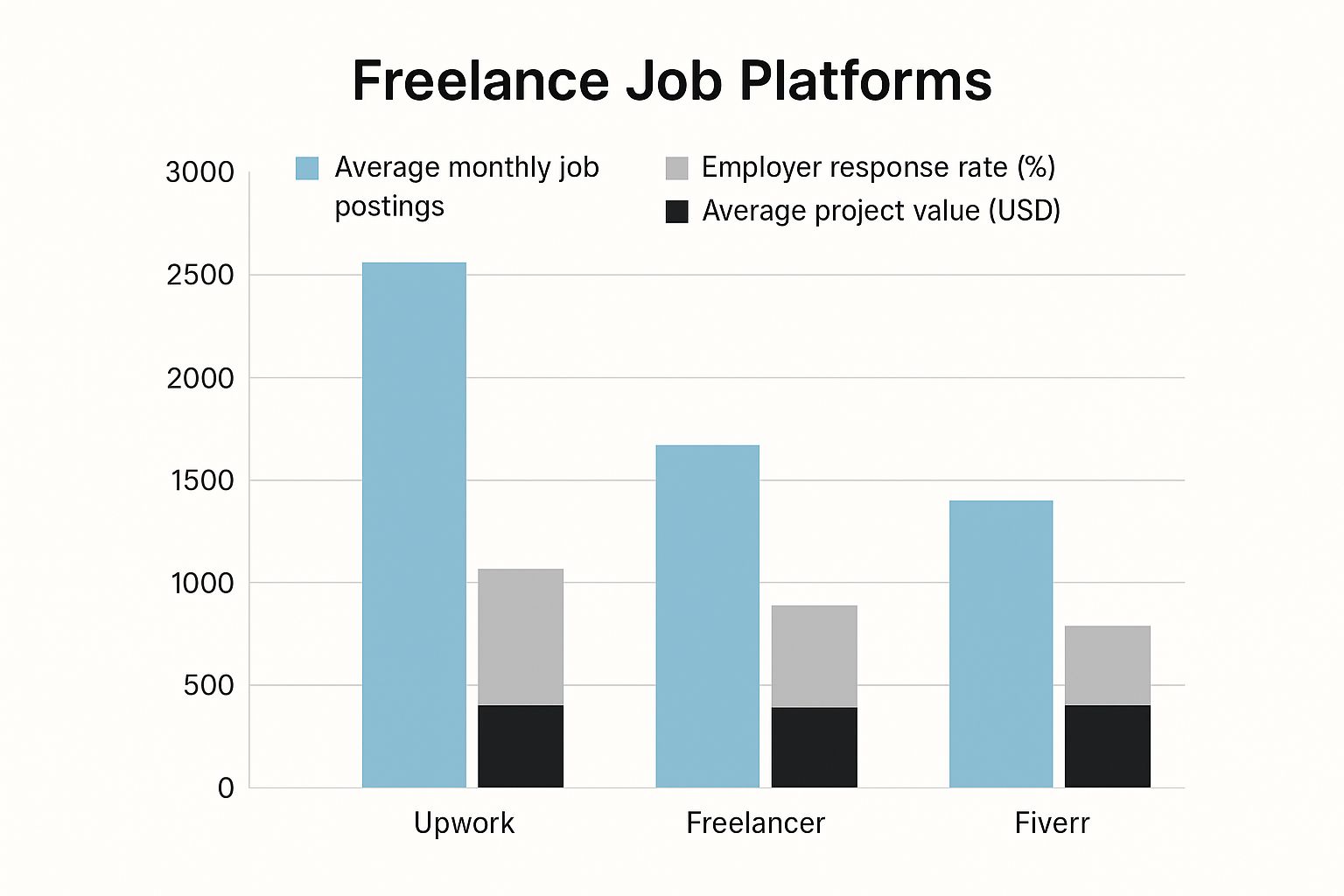Understanding What Today's Freelance Market Really Looks Like

Before you start polishing your profile or sending out pitches, it’s important to get a clear picture of the world you’re entering. Knowing how to get freelance clients isn't what it used to be. The days of just listing your skills and waiting for the work to find you are over. The market is definitely more crowded, but it’s also bursting with opportunities if you know where to look.
Here’s the thing: more businesses are hiring freelancers, but they’ve also become smarter about who they hire. They aren’t just looking for someone to complete a task; they’re looking for a partner who can solve a real business problem. This is a crucial detail. A client hiring a logo designer isn't just buying a graphic. They're buying a visual identity that helps them connect with their customers. This change in thinking is your secret weapon. Instead of just selling services, you need to start selling results.
The Big Picture: Growth and Competition
The global freelance market has exploded, and it’s projected to be worth over $500 billion by 2025. This growth is driven by millions of professionals building their careers on platforms like Fiverr, which anticipates a 10–12% increase in new freelancers in 2025 and expects to handle around 25 million jobs. This creates a double-edged sword: massive demand on one side, and intense competition on the other. To make it, you can't afford to be just another face in the crowd. You can dig deeper into these trends by checking out these freelancing statistics.
Identifying High-Value vs. High-Effort Clients
This busy market naturally has different types of clients. Learning to spot them is the key to building a profitable business without burning out. Your main goal is to move past the high-effort, low-reward clients as fast as you can.
Here’s a quick guide to who you'll meet:
- The Bargain Hunters: These clients care about one thing: price. They often have fuzzy requirements and treat freelancers like they’re interchangeable. They might give you your first gig, but they won't help you build a sustainable career.
- The Do-It-Yourselfers (DIY-ers): This group tried to solve the problem on their own and failed. They usually have more respect for your skills than bargain hunters, but their budgets can be tight, and they might hover over your shoulder.
- The Strategic Investors: These are the clients you're after. They see hiring an expert as an investment, not just an expense. They have clear goals, respect your knowledge, and focus on the value you bring. They want a partner, not just a pair of hands.
The first step in landing great freelance clients is learning to recognize who you're talking to. If a potential client's first question is "What's your hourly rate?", it's often a red flag that they prioritize cost over quality. On the other hand, a client who starts by explaining their business challenges is likely a strategic investor you should focus on. Your entire approach, from your profile to your proposals, should be designed to attract and win over these high-value partners.
Building a Profile That Actually Gets You Noticed

Once you've got a handle on the market, it’s time to build a profile that works for you around the clock. Your online presence—whether on Upwork, LinkedIn, or your personal site—is your silent salesperson. This is where most freelancers stumble. They create profiles that are all about them: "I'm a passionate writer," or "I have five years of design experience." Here’s a tough truth: potential clients don’t really care about you; they care about their own problems. The real secret to getting noticed is to stop talking about your resume and start talking about their results.
Your profile isn't a dry list of past jobs. It’s a direct conversation with your ideal client about their biggest headaches. Making this mental switch is what separates freelancers who are booked solid from those who are constantly on the hunt.
From "About Me" to "About Them"
The best profiles don’t lead with a laundry list of skills; they lead with empathy. They immediately show a potential client that you understand their world. A headline like "Freelance Graphic Designer" is easy to ignore. But what about, "I Help E-commerce Brands Boost Conversions with Product Images That Actually Sell"? The second one hits differently. It speaks directly to a business goal and tells the client you’re not just making pretty pictures—you're focused on their bottom line.
This same idea applies to your bio or summary. Instead of just listing the tools you know, describe the outcomes you create for people.
- Instead of: "Proficient in Adobe Illustrator and Photoshop."
- Try: "I turn complex data into clear, engaging infographics that your audience will actually want to share, boosting your content's reach and authority."
This simple change positions you as a strategic partner, not just someone who executes tasks. When a business owner is looking for a pro to trust with their brand, that distinction is everything. For a peek behind the curtain, our guide on hiring a freelance graphic designer offers some great insights from the client's point of view.
Before we dive into your portfolio, let's look at how different parts of your profile can influence a client's decision to reach out. The table below breaks down the key elements and their impact.
| Profile Element | Client Response Rate | Conversion Impact | Time Investment |
|---|---|---|---|
| Client-Focused Headline | High (50-60% increase) | High | Low (15-30 mins) |
| Generic "About Me" Bio | Low (5-10% increase) | Low | Low (15-30 mins) |
| Problem/Solution Bio | High (40-50% increase) | High | Medium (1-2 hours) |
| Curated Portfolio with Case Studies | Very High (70-80% increase) | Very High | High (2-4 hours per project) |
| Unexplained Project Gallery | Low (10-20% increase) | Low | Medium (1-2 hours total) |
As you can see, investing a bit more time into crafting a client-focused narrative and detailed case studies can dramatically increase your chances of not just getting noticed, but getting hired.
Show, Don't Just Tell: The Power of a Curated Portfolio
Your portfolio is your most convincing proof. Resist the urge to dump every single project you've ever worked on into one giant folder. Instead, curate it. Hand-pick 3-5 of your absolute best projects that reflect the kind of work you want to attract more of. For each one, don't just display the final image. Tell the story behind it.
Craft a mini-case study for each portfolio piece:
- The Challenge: What was the client's pain point? (e.g., "A local coffee shop was struggling with dead weekdays and low foot traffic.")
- Your Solution: What specific steps did you take? (e.g., "I designed a 'Weekday Warrior' loyalty card and a series of social media graphics promoting a new mid-week discount.")
- The Result: What was the measurable outcome? Use real numbers whenever possible. (e.g., "The campaign resulted in a 15% increase in weekday sales within the first month.")
This approach proves your value in a concrete way. Even if your portfolio is small, a few well-explained case studies build far more trust than a gallery of fifty unexplained images. To really make your professional profiles shine, learning the essentials of optimizing your LinkedIn profile is a critical piece of the puzzle. Your profile is often the very first impression you make—so make it count.
Mastering Platform Strategy Without Racing to the Bottom

Freelance platforms can feel like a crowded marketplace where everyone is shouting about being the cheapest. It’s easy to get discouraged and think the only way to win is to join that race to the bottom. But here's a secret: the most successful freelancers on these sites aren't the cheapest; they're the smartest. They understand that platforms like Upwork and Fiverr are just tools—and like any tool, success is all about how you use it.
Your goal isn't just to find work, it's to find the right work. This means figuring out how to get freelance clients who respect your expertise and are willing to pay for value, even in a competitive space. The key is to shift your mindset from a desperate job applicant to a strategic business owner who is selectively choosing their projects.
This approach is more important than ever. The freelance platforms market is on a massive growth trajectory, projected to expand from $7.65 billion in 2025 to $16.54 billion by 2030. This incredible growth means a flood of new clients are joining these platforms every day, and many of them are looking for high-quality experts, not just low-cost labor. You can dive deeper into this trend by exploring the latest Upwork user data. Your job is to make it easy for those premium clients to find you.
Playing the Platform Game to Win
Every platform has its own algorithm that decides which freelancers get shown to clients. While the exact formulas are secret, they consistently reward a few key behaviors. To get the algorithm on your side, you need to focus on what the platform wants: successful project completions and happy clients.
Here are a few ways to work the system, ethically:
- Chase "Top Rated" Status (or the equivalent): This badge is a huge trust signal for clients and a massive boost for your visibility. Focus on delivering exceptional work on your first few projects, communicating clearly, and getting stellar reviews. This initial effort pays off for years to come.
- Respond Quickly: Many platforms track how fast you reply. Answering inquiries promptly shows you’re active and engaged, which the algorithm loves.
- Keep Your Profile Fresh: Even small tweaks to your bio or portfolio can signal to the platform that your profile is current, which can help your ranking in search results.
- Be Selective with Your Bids: Applying for every job you see is a recipe for burnout and signals desperation. Instead, focus your energy on a few high-quality listings where you're a perfect fit. Platforms notice when your application-to-hire ratio is strong.
Writing Proposals That Stand Out
Your proposal is your single best chance to cut through the noise. Most freelancers send generic, copy-pasted proposals that scream, "I didn't even read your job post." To win, you need to do the exact opposite.
Here’s a structure for a proposal that actually gets noticed:
| Section of Proposal | Purpose | Example Snippet |
|---|---|---|
| The Hook | Acknowledge their specific problem. | "I see you're looking for a writer to create blog posts that attract organic traffic for your new SaaS product. I specialize in just that…" |
| The Solution | Briefly explain your approach. | "My process involves identifying low-competition keywords your ideal customers are searching for and then crafting in-depth, valuable articles…" |
| The Proof | Link to 1-2 highly relevant portfolio pieces. | "…similar to the results I achieved for [Previous Client], where we saw a 30% increase in organic traffic in two months." |
| The Question | End with a question to start a conversation. | "What does your current content promotion strategy look like? I have a few ideas on how we could amplify these posts." |
This approach immediately shows the client you’ve read their brief, understand their needs, and have a plan. You're no longer just another bidder; you're a potential partner.
Ultimately, mastering platforms is about building a reputation for quality. It takes more effort upfront than just setting a low price, but it leads to better clients, higher rates, and more sustainable success. As you build your client base, you'll find great opportunities across different industries. You might also be interested in exploring our guide on finding freelance creative jobs to broaden your search. The goal is to use these platforms as a springboard, not a ceiling, for your freelance career.
Creating Your Personal Client Acquisition System
Scrambling for work every month is exhausting. That feast-or-famine cycle is what burns out so many talented freelancers. The answer isn't to just hustle harder; it's to build a system. Think of it this way: a restaurant doesn't just hope customers show up. They have marketing, a reservations system, and a process for serving people. You need that same intentional approach for getting freelance clients.
This means creating a repeatable process that consistently brings in leads without eating up all your non-billable hours. It's about being strategic with the time you already have. Client acquisition is a major time investment, but successful freelancers are masters of efficiency. Research from a 2025 study drives this point home: 47% of freelancers spend 10–20% of their work time finding new clients, while 37% spend less than 10%. This proves that with the right system, you don't need to be in constant "sales mode." You can find out more about how freelancers are managing their time and acquisition efforts to stay ahead.
The 80/20 Rule of Client Acquisition
The first part of building your system is figuring out what actually works. It's so easy to waste hours on a dozen different strategies—cold emailing, content marketing, platform bidding, social media—without knowing which one is delivering the goods. This is where the Pareto Principle, also known as the 80/20 rule, becomes your best friend. The idea is simple: roughly 80% of your results will come from 20% of your efforts.
Your job is to find your 20%. Take a look at your last 5-10 clients. Where did they come from?
- Was it a referral from a happy past client?
- A cold pitch you sent on LinkedIn?
- An application on a freelance platform?
- Someone who found your portfolio through a Google search?
Track this information in a simple spreadsheet. After a few months, you'll start to see a pattern. Maybe you’ll realize that while you spend tons of time on social media, your best-paying clients actually come from targeted proposals on niche job boards. That’s your cue to double down on what’s effective and scale back on the rest.
The infographic below shows how different platforms can lead to different outcomes, helping you decide where to focus your energy.

As the data suggests, platforms with fewer job postings can sometimes provide higher average project values and better employer response rates. This really underlines the importance of quality over quantity when choosing where to spend your time.
Designing Your Weekly Acquisition "Sprints"
Once you know your most profitable channels, turn them into a repeatable weekly routine. Instead of randomly looking for work whenever anxiety strikes, dedicate specific blocks of time to client acquisition. This is a concept called time batching, and it’s incredibly effective for staying consistent.
To give you a better idea of how your time investment can pay off, let's look at some potential outcomes. The table below shows the relationship between the percentage of your workweek you dedicate to client acquisition and the success you might see.
Time Investment vs. Client Acquisition Success Rates
Data showing the relationship between time spent on client acquisition and success metrics
| Time Investment % | Average New Clients/Month | Quality Score | Revenue Impact |
|---|---|---|---|
| <5% | 0-1 | Low-Medium | Inconsistent, feast-or-famine |
| 10% | 1-2 | Medium | Stable, predictable income |
| 15% | 2-3 | Medium-High | Steady growth, better projects |
| 20%+ | 3+ | High | Rapid growth, ability to be selective |
This data shows a clear link: a more consistent time investment leads to more clients, higher-quality projects, and a healthier bottom line. Even dedicating just 10% of your time can create a stable pipeline.
Here’s what a weekly acquisition "sprint" might look like for a freelance writer:
- Monday (9 AM – 10 AM): Research 10 ideal companies and find key contact people.
- Tuesday (9 AM – 10 AM): Draft and send 5 personalized cold emails.
- Wednesday (9 AM – 10 AM): Engage with 5 potential clients on LinkedIn (comment on their posts, share their content).
- Thursday (9 AM – 10 AM): Follow up on last week's emails and send 5 more personalized pitches.
- Friday (9 AM – 10 AM): Review your tracking sheet and update your lead pipeline.
This systematic approach turns a massive task into a manageable habit. You’re no longer just looking for clients; you are actively generating leads. Exploring effective digital marketing strategies for service businesses can provide more ideas for your sprints. The ultimate goal is to build a predictable pipeline, which is the foundation of any healthy freelance business. With a solid system in place, you can focus your energy on delivering amazing work, confident that new opportunities are always just around the corner.
Building Real Relationships That Send You Business
While a sharp profile and a solid proposal strategy are important, many of your best, highest-paying projects will come from a place algorithms can't touch: real human relationships. This isn't about collecting a stack of business cards at a conference or blasting out generic connection requests. It’s about building a genuine network of peers, mentors, and collaborators who trust you and want you to succeed. The goal is to be the first person they think of when an opportunity pops up.
The most powerful networking is rooted in generosity. Instead of thinking, "What can I get out of this?" try shifting your mindset to, "What can I offer?" This simple change turns you from a taker into a valuable connector. When you approach relationships with a desire to help, you build social capital that pays off later. This is the secret to getting freelance clients who are already warmed up and ready to work with you.
How to Use Online Communities the Right Way
These days, some of the most effective networking happens online. Niche Facebook groups, Slack channels, and industry-specific forums can be goldmines for making connections. But just joining a group isn’t enough. A common mistake freelancers make is lurking silently or, worse, dropping a portfolio link and vanishing. To build real relationships, you have to participate and provide value.
- Answer questions with care. When someone asks for advice in your field, give a detailed, helpful response without expecting anything in return.
- Share useful resources. Found an amazing article or a handy tool? Share it with the group and explain why it’s so good.
- Engage with what others post. Celebrate their wins, offer constructive feedback when it's requested, and show you're genuinely interested in their work.
This screenshot shows a typical exchange in a professional LinkedIn group where a member is asking for advice.
Notice how the most helpful comments aren't self-promotional. They offer direct advice and resources. By consistently being a helpful voice, you establish yourself as a knowledgeable and generous expert, making people eager to send business your way.
The Art of the Meaningful Follow-Up
Meeting someone—whether online or in person—is just the starting point. The real connection is built in the follow-up, which is where most people miss their chance. A great follow-up solidifies the connection and keeps you on their radar without being pushy. After a conversation, send a personalized message that mentions something specific you talked about. For example, "It was great chatting about your podcast launch! Here’s that article I mentioned on audio editing software."
This shows you were actually listening. From there, you can keep the relationship warm by occasionally checking in with something helpful. This isn't just about finding clients; it's about building a professional circle that supports your growth. Interestingly, these same principles of consistent value and follow-up are key to keeping clients for the long haul. In fact, our guide on how to retain clients shows how strong relationships are the foundation of a stable freelance business.
Ultimately, your network's strength is measured by its quality, not its size. A handful of strong, mutual relationships will bring you more high-quality work than a thousand passive connections. Focus on being the kind of freelancer other people want to help, and you'll find that opportunities start coming to you.
Writing Proposals That Win Projects Every Time
Your portfolio grabbed their attention, and your profile built that initial layer of trust. Now comes the proposal—this is where the deal is truly won or lost. Many freelancers fall into the trap of playing a numbers game, blasting out dozens of generic templates and hoping one lands. The winning approach, however, is about quality, not quantity. It’s about showing the client you didn’t just see their job post; you understood it.
A powerful proposal instantly shifts you from being just another applicant to a proactive problem-solver. It demonstrates that you've invested time in understanding their specific needs and have already started thinking about solutions. This simple shift in focus builds immediate credibility and sets you apart from the 90% of applicants who send a generic, "me-focused" pitch.
From Application to Conversation Starter
The biggest mistake I see freelancers make is writing proposals that read like a resume. They’re full of "I can do this" and "I have experience in that." But here's the thing: your proposal should be about the client. The goal isn’t to list your skills; it’s to show how those skills will solve their problem and deliver real results.
Think of it this way: a client isn’t just buying your services; they’re buying a solution to a business pain point. Frame your entire proposal around that solution.
- Acknowledge their exact problem: Start by rephrasing their challenge in your own words. This shows you've paid attention. For example, "I understand you're looking to increase organic traffic to your new e-commerce store, but you're struggling to rank for competitive keywords."
- Outline your unique approach: Briefly explain how you'll tackle their problem. This is your chance to showcase your process. For instance, "My strategy would start by identifying long-tail keywords your ideal customers are actively searching for. Then, we'll create in-depth blog content that answers their questions and positions your brand as a go-to authority."
- Provide hyper-relevant proof: Link to one or two specific case studies or portfolio pieces that directly relate to their project. Resist the urge to send your entire portfolio. Relevance is everything.
Imagine scrolling through a job feed on a platform like Upwork, where hundreds of freelancers are vying for the same projects.
Each one of those listings is a chance to craft a specific, client-focused proposal that cuts through the noise.
Handling Objections and Pricing Before They Ask
A great proposal anticipates and addresses potential client concerns, and the most common one is always about money. Instead of just stating a flat fee, you need to frame it in terms of value. Don't just list a price; present it as an investment with clear outcomes.
Here’s a simple table structure you can adapt to communicate this value clearly in your proposals:
| Service Tier | Key Deliverables | Investment |
|---|---|---|
| Starter SEO Package | Keyword Research, 2 Blog Posts (1,000 words each), Basic On-Page SEO | $800 |
| Growth SEO Package | Everything in Starter, plus 2 more blog posts and a monthly content plan. | $1,500 |
| Authority SEO Package | Everything in Growth, plus backlink outreach and a performance report. | $2,500 |
This tiered approach shifts the conversation from, "How much do you cost?" to, "Which level of value is right for my business?" It also helps you avoid being directly compared on price alone with other freelancers. By presenting your services with confidence and clarity, you transform your proposal from a simple price quote into a compelling business case that makes clients feel confident in their decision to hire you.
Scaling Beyond the Hustle to Sustainable Growth
You’ve mastered proposals and have a steady stream of projects. Awesome. But now the real work begins: breaking free from the "trading time for money" cycle. The hustle that got you this far isn't what will carry you to the next level. Sustainable growth isn’t about cramming more hours into your day; it’s about working smarter and building a business that generates its own momentum. This is the point where you shift from actively hunting for work to creating a reputation that pulls clients directly to you.
The mental shift here is huge. You need to stop seeing yourself as just a freelancer and start thinking like a business owner. This means building systems, polishing your brand, and strategically boosting your value. It’s the difference between just earning a living and actually building something lasting.
From Service Provider to Go-To Expert
The bedrock of scaling your freelance work is your positioning. The goal is to become the go-to expert in your niche—the name that pops up when a high-value client has a problem you’re uniquely suited to solve. This comes down to a few key actions:
- Systemize Your Success: Your happiest clients are your most powerful marketing tool. It's time to create a formal referral system. After wrapping up a project successfully, don't just cross your fingers and hope for a referral; ask for it directly. You could offer a small discount on future work or a finder's fee for any new client they introduce. This simple step turns satisfied customers into an active, motivated sales team.
- Raise Your Rates Strategically: Once your calendar is full and you have a portfolio packed with success stories, it’s time to increase your prices. A good rule of thumb is to raise your rates by 15-25% every six months or after every 3-5 major projects. Don’t spring this on existing clients out of the blue. Instead, apply the new rate to all new leads. For your long-term partners, give them plenty of notice and explain that your new rates reflect your improved skills and the consistent results you deliver.
- Productize Your Services: Turn your most common requests into well-defined, tiered packages. Instead of creating a custom quote for every single inquiry, you can offer something like a "Startup Brand Package" or a "Monthly Content Growth Plan." This not only simplifies your sales process but also makes your value crystal clear and helps you streamline your workflow. When you start managing multiple packaged projects, good creative project management software can be a lifesaver for keeping everything organized.
Building Your Business, Not Just Your Client List
True scaling means your business is growing even when you’re not out there actively looking for new work. This is all about building assets that generate leads on their own. Think about creating a high-value lead magnet for your website, starting a niche-specific newsletter, or consistently sharing your expertise on a social media platform you enjoy. Every piece of content you create acts like a tiny salesperson, working for you 24/7.
For anyone serious about turning their freelance career into a durable business, learning from those who've already made the leap is invaluable. Reading about the journey from freelancer to consultant offers a roadmap, showing how others built lasting success. This is the final piece of the puzzle in learning how to get freelance clients—it’s about building a brand so strong that the best clients start looking for you.
Ready to find the high-quality clients you deserve? Creativize connects talented creative professionals like you with businesses actively searching for your skills. Build your free portfolio on Creativize today and let your next great project find you.

